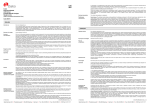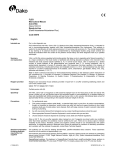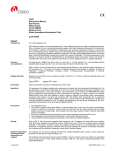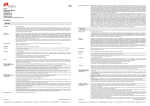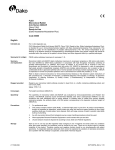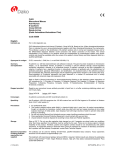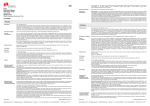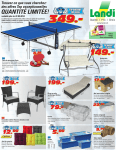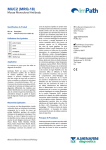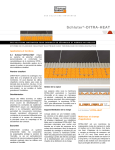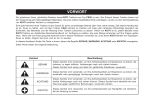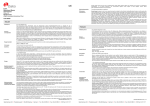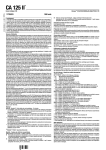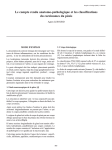Download FLEX Monoclonal Mouse Anti-Human Cytokeratin 20 Clone
Transcript
aqueous, permanent mounting medium is recommended. Positive and negative controls should be run simultaneously using the same protocol as the patient specimens. The positive control tissue should include colon and the cells/structures should display reaction patterns as described for this tissue in “Performance characteristics” in all positive specimens. The recommended negative control reagent is FLEX Negative Control, Mouse, (Dako Autostainer/Autostainer Plus) (Code IS750). FLEX Monoclonal Mouse Anti-Human Cytokeratin 20 Clone Ks20.8 Ready-to-Use (Dako Autostainer/Autostainer Plus) Staining interpretation Cells labeled by the antibody display cytoplasmic staining. Performance characteristics Normal tissues: The antibody labels normal urothelium (1, 4) and the mature epithelium lining the villi of duodenal mucosa (1). CK20 immunoreactivity has not been detected in a number of non-epithelial tissues tested, such as smooth muscle, blood vessel walls, lymph nodes and tumor stroma (1). In columnar epithelial cells in colon, the luminal cells show a moderate to strong staining reaction, whereas the basal to intermediate cells show a weak to moderate staining reaction. Abnormal tissues: In colonic adenocarcinoma, the antibody labeled 26 of 27 tumors (96%). 21 (78%) displayed staining in more than 50% of the cells (3). Of 51 patients with urothelial papillomas of the bladder, 10 showed labeling of superficial urothelial cells (normal labeling) with the antibody. None of these patients showed further tumors during the follow up. By contrast, 30 patients (73%) showed CK20 expression in all cell layers (abnormal labeling) and developed further tumors (4). 3 out of 4 metastatic gastric tumors were labeled by the antibody (5). Focal immunostaining with the antibody (less than 10% positive cells) was observed in 9 of 65 lung, 1 of 20 breast, and 2 of 11 endometrial tumors. 1 of 19 clear-cell type renal cell carcinomas was positive in 10-50% of the cells (3). None of 10 primary ovarian carcinomas and none of 5 mesotheliomas were found positive with the antibody (5). CK20 may occasionally be expressed in breast and lung adenocarcinomas, and in squamous cell carcinomas (1, 3). Less than 5% CK20 positive cells may be present in a number of tissues not generally considered CK-20-positive (1). Code IS777 ENGLISH Intended use For in vitro diagnostic use. FLEX Monoclonal Mouse Anti-Human Cytokeratin 20, Clone Ks20.8, Ready-to-Use, (Dako Autostainer/Autostainer Plus), is intended for use in immunohistochemistry together with Dako Autostainer/Autostainer Plus instruments. This antibody labels normal and abnormal gastric and intestinal epithelium, urothelium and Merkel cells (1, 2), and this antibody is of particular value in the classification of carcinomas originating from these cell types (1, 3-5). The clinical interpretation of any staining or its absence should be complemented by morphological studies using proper controls and should be evaluated within the context of the patient's clinical history and other diagnostic tests by a qualified pathologist. Synonym for antigen Protein IT (6). Summary and explanation Cytokeratin 20 (CK20) belongs to the intermediate filament proteins, which create a cytoskeleton in almost all cells. In contrast to other intermediate filaments, cytokeratins (CKs) are made up of a highly complex multigene family of 40 to 68 kDa polypeptides (1, 7). 20 distinct CK polypeptides have been revealed in various human epithelial cells and their malignant counterparts (1, 2, 7). They can be divided into an acidic (type I) and a neutral-basic (type II) subfamily. CK20, a 46 kDa protein, is less acidic than the other type I cytokeratins. CK20 positivity (5-100% CK-20-positive tumor cells) has been reported in the vast majority of adenocarcinomas of the colon, mucinous ovarian tumors, transitional-cell and Merkel cell carcinomas, and frequently also in adenocarcinomas of the stomach (50%), bile system (75%), and pancreas (40%). Less than 2% of breast and lung adenocarcinomas and squamous cell carcinomas were positive, while adenocarcinomas of the ovary (non-mucinous) and endometrium, and renal cell and small cell carcinomas showed only scattered positive cells in some cases (1). Refer to Dako’s General Instructions for Immunohistochemical Staining or the detection system instructions of IHC procedures for: 1) Principle of Procedure, 2) Materials Required, Not Supplied, 3) Storage, 4) Specimen Preparation, 5) Staining Procedure, 6) Quality Control, 7) Troubleshooting, 8) Interpretation of Staining, 9) General Limitations. Reagent provided Ready-to-use monoclonal mouse antibody provided in liquid form in a buffer containing stabilizing protein and 0.015 mol/L sodium azide. Clone: Ks20.8 (1). Isotype: IgG2a, kappa. Immunogen CK20 isolated by SDS-PAGE from cytoskeletal material obtained from human duodenal mucosa (1). Specificity In Western immunoblotting of SDS-PAGE-separated cytoskeletal proteins from human duodenal mucosa, the antibody labels a 46 kDa polypeptide corresponding to CK20 (1). Precautions 1. For professional users. 2. This product contains sodium azide (NaN3), a chemical highly toxic in pure form. At product concentrations, though not classified as hazardous, sodium azide may react with lead and copper plumbing to form highly explosive build-ups of metal azides. Upon disposal, flush with large volumes of water to prevent metal azide build-up in plumbing. 3. As with any product derived from biological sources, proper handling procedures should be used. 4. Wear appropriate Personal Protective Equipment to avoid contact with eyes and skin. 5. Unused solution should be disposed of according to local, State and Federal regulations. Storage Store at 2-8 °C. Do not use after expiration date sta mped on vial. If reagents are stored under any conditions other than those specified, the conditions must be verified by the user. There are no obvious signs to indicate instability of this product. Therefore, positive and negative controls should be run simultaneously with patient specimens. If unexpected staining is observed which cannot be explained by variations in laboratory procedures and a problem with the antibody is suspected, contact Dako Technical Support. Specimen preparation including materials required but not supplied Staining procedure including materials required but not supplied The antibody can be used for labeling formalin-fixed, paraffin-embedded tissue sections. Tissue specimens should be cut into sections of approximately 4 µm. Pre-treatment with heat-induced epitope retrieval (HIER) is required using Dako PT Link (Code PT100/PT101). For details, please refer to the PT Link User Guide. Optimal results are obtained by pretreating tissues using EnVision FLEX Target Retrieval Solution, High pH (50x) (Code K8010/K8004). Paraffin-embedded sections: Pre-treatment of formalin-fixed, paraffin-embedded tissue sections is recommended using the 3-in-1 specimen preparation procedure for Dako PT Link. Follow the pre-treatment procedure outlined in the package insert for EnVision FLEX Target Retrieval Solution, High pH (50x) (Code K8010/K8004). Note: After staining the sections must be dehydrated, cleared and mounted using permanent mounting medium. Deparaffinized sections: Pre-treatment of deparaffinized formalin-fixed, paraffin-embedded tissue sections is recommended using Dako PT Link and following the same procedure as described for paraffin-embedded sections. After staining the slides should be mounted using aqueous or permanent mounting medium. The tissue sections should not dry out during the treatment or during the following immunohistochemical staining procedure. For greater adherence of tissue sections to glass slides, the use of FLEX IHC Microscope Slides (Code K8020) is recommended. The recommended visualization system is EnVision FLEX, High pH, (Dako Autostainer/Autostainer Plus) (Code K8010). The staining steps and incubation times are pre-programmed into the software of Dako Autostainer/Autostainer Plus instruments, using the following protocols: Template protocol: FLEXRTU2 (200 µL dispense volume) or FLEXRTU3 (300 µL dispense volume) Autoprogram: CK20 (without counterstaining) or CK20H (with counterstaining) The Auxiliary step should be set to “rinse buffer” in staining runs with ≤10 slides. For staining runs with >10 slides the Auxiliary step should be set to “none”. This ascertains comparable wash times. All incubation steps should be performed at room temperature. For details, please refer to the Operator’s Manual for the dedicated instrument. If the protocols are not available on the used Dako Autostainer instrument, please contact Dako Technical Services. Optimal conditions may vary depending on specimen and preparation methods, and should be determined by each individual laboratory. If the evaluating pathologist should desire a different staining intensity, a Dako Application Specialist/Technical Service Specialist can be contacted for information on re-programming of the protocol. Verify that the performance of the adjusted protocol is still valid by evaluating that the staining pattern is identical to the staining pattern described in “Performance characteristics”. Counterstaining in hematoxylin is recommended using EnVision FLEX Hematoxylin, (Dako Autostainer/Autostainer Plus) (Code K8018). Non- (115229-002) Dako Denmark A/S IS777/EFG/MNI/2009.12.04 p. 1/4 | Produktionsvej 42 | DK-2600 Glostrup | Denmark | Tel. +45 44 85 95 00 | Fax +45 44 85 95 95 | CVR No. 33 21 13 17 FRANÇAIS Utilisation prévue Pour utilisation diagnostique in vitro. FLEX Monoclonal Mouse Anti-Human Cytokeratin 20, clone Ks20.8, Ready-to-Use, (Dako Autostainer/Autostainer Plus), est destiné à une utilisation en immunohistochimie avec les instruments Dako Autostainer/Autostainer Plus. Cet anticorps marque l’épithélium gastrique et intestinal normal et anormal, l’urothélium et les cellules de Merkel (1, 2) et il s’avère particulièrement utile dans la classification des carcinomes issus de ces types de cellules (1, 3-5). L’interprétation clinique de toute coloration ou son absence doit être complétée par des études morphologiques en utilisant des contrôles appropriés et doit être évaluée en fonction des antécédents cliniques du patient et d’autres tests diagnostiques par un pathologiste qualifié. Synonyme de l’antigène Protéine IT (6). Résumé et explication La cytokératine 20 (CK20) fait partie des filaments intermédiaires, qui créent un cytosquelette dans presque toutes les cellules. À la différence des autres filaments intermédiaires, les cytokératines (CK) sont constituées d’une famille multigénique hautement complexe de polypeptides dont les poids moléculaires varient entre 40 et 68 kDa (1, 7). On a recensé 20 CK différentes dans diverses cellules épithéliales humaines et leurs homologues tumorales (1, 2, 7). Les CK peuvent être divisées en sous-familles : type I acide et type II neutre-basique. La CK20, une protéine de 46 kDa, est moins acide que les autres cytokératines de type I. La CK20 a été détectée (5 à 100 % de cellules tumorales positives à la CK 20) dans la majorité des adénocarcinomes du côlon, des tumeurs ovariennes mucineuses, des carcinomes à cellules transitionnelles et à cellules de Merkel et également très souvent dans les adénocarcinomes de l’estomac (50 %), du système biliaire (75 %) et du pancréas (40 %). Moins de 2 % des adénocarcinomes du sein et du poumon et des carcinomes à cellules squameuses sont positifs, alors que les adénocarcinomes de l’ovaire (non mucineux) et de l’endomètre, ainsi que les carcinomes à cellules rénales et à petites cellules présentent uniquement des cellules positives isolées dans certains cas (1). Se référer aux Instructions générales de coloration immunohistochimique de Dako ou aux instructions du système de détection relatives aux procédures IHC pour plus d’informations concernant les points suivants : 1) Principe de procédure, 2) Matériels requis mais non fournis, 3) Conservation, 4) Préparation des échantillons, 5) Procédure de coloration, 6) Contrôle qualité, 7) Dépannage, 8) Interprétation de la coloration, 9) Limites générales. Réactifs fournis Anticorps monoclonal de souris prêt à l’emploi fourni sous forme liquide dans un tampon contenant une protéine stabilisante et 0,015 mol/L d’azide de sodium. Clone : Ks20.8 (1). Isotype : IgG2a, kappa. Immunogène CK20 isolée par immunoblot PAGE en présence de SDS à partir de matériau cytosquelettique provenant de muqueuse duodénale humaine (1). Spécificité Dans les analyses de protéines cytosquelettiques de la muqueuse duodénale humaine réalisées par Western immunoblot PAGE en présence de SDS, l’anticorps marque un polypeptide de 46 kDa correspondant à la CK20 (1). Précautions 1. Pour utilisateurs professionnels. 2. Ce produit contient de l’azide de sodium (NaN3), produit chimique hautement toxique dans sa forme pure. Aux concentrations du produit, bien que non classé comme dangereux, l’azide de sodium peut réagir avec le cuivre et le plomb des canalisations et former des accumulations d’azides métalliques hautement explosifs. Lors de l’élimination, rincer abondamment à l’eau pour éviter toute accumulation d’azide métallique dans les canalisations. 3. Comme avec tout produit d’origine biologique, des procédures de manipulation appropriées doivent être respectées. 4. Porter un vêtement de protection approprié pour éviter le contact avec les yeux et la peau. 5. Les solutions non utilisées doivent être éliminées conformément aux réglementations locales et nationales. Conservation Conserver entre 2 et 8 °C. Ne pas utiliser après la date de péremption imprimée sur le flacon. Si les réactifs sont conservés dans des conditions autres que celles indiquées, celles-ci doivent être validées par l’utilisateur. Il n’y a aucun signe évident indiquant l’instabilité de ce produit. Par conséquent, des contrôles positifs et négatifs doivent être testés en même temps que les échantillons de patient. Si une coloration inattendue est observée, qui ne peut être expliquée par un changement des procédures du laboratoire, et en cas de suspicion d’un problème lié à l’anticorps, contacter l’assistance technique de Dako. Préparation des échantillons y compris le matériel requis mais non fourni L’anticorps peut être utilisé pour le marquage des coupes de tissus inclus en paraffine et fixés au formol. L’épaisseur des coupes d’échantillons de tissu doit être d’environ 4 µm. Un prétraitement avec démasquage d’épitope induit par la chaleur (HIER) est nécessaire avec le Dako PT Link (Réf. PT100/PT101). Pour plus de détails, se référer au Guide d’utilisation du PT Link. Des résultats optimaux sont obtenus en prétraitant les tissus à l’aide de la EnVision FLEX Target Retrieval Solution, High pH (50x) (Réf. K8010/K8004). Coupes incluses en paraffine : le prétraitement des coupes tissulaires fixées au formol et incluses en paraffine est recommandé à l'aide de la procédure de préparation d'échantillon 3-en-un pour le Dako PT Link. Suivre la procédure de prétraitement indiquée dans la notice de la EnVision FLEX Target Retrieval Solution, High pH (50x) (Réf. K8010/K8004). Remarque : après coloration, les coupes doivent être déshydratées, lavées et montées à l’aide d’un milieu de montage permanent. Coupes déparaffinées : le prétraitement des coupes tissulaires déparaffinées, fixées au formol et incluses en paraffine, est recommandé à l’aide du Dako PT Link, en suivant la même procédure que pour les coupes incluses en paraffine. Après coloration, un montage aqueux ou permanent des lames est recommandé. Les coupes de tissus ne doivent pas sécher lors du traitement ni lors de la procédure de coloration immunohistochimique suivante. Pour une meilleure adhérence des coupes de tissus sur les lames de verre, il est recommandé d’utiliser des lames FLEX IHC Microscope Slides (Réf. K8020). Procédure de coloration y compris le matériel requis mais non fourni Le système de visualisation recommandé est le EnVision FLEX, High pH, (Dako Autostainer/Autostainer Plus) (Réf. K8010). Les étapes de coloration et d’incubation sont préprogrammées dans le logiciel des instruments Dako Autostainer/Autostainer Plus, à l’aide des protocoles suivants : (115229-002) Dako Denmark A/S IS777/EFG/MNI/2009.12.04 p. 2/4 | Produktionsvej 42 | DK-2600 Glostrup | Denmark | Tel. +45 44 85 95 00 | Fax +45 44 85 95 95 | CVR No. 33 21 13 17 Protocole modèle : FLEXRTU2 (volume de distribution de 200 µL) ou FLEXRTU3 (volume de distribution de 300 µL) Autoprogram : CK20 (sans contre-coloration) ou CK20H (avec contre-coloration). L’étape Auxiliary doit être réglée sur « rinse buffer » lors des cycles de coloration avec ≤10 lames. Pour les cycles de coloration de >10 lames, l’étape Auxiliary doit être réglée sur « none ». Cela confirme des temps de lavage comparables. Toutes les étapes d’incubation doivent être effectuées à température ambiante. Pour plus de détails, se référer au Manuel de l’opérateur spécifique à l'instrument. Si les protocoles ne sont pas disponibles sur l’instrument Dako Autostainer utilisé, contacter le service technique de Dako. Les conditions optimales peuvent varier en fonction du prélèvement et des méthodes de préparation, et doivent être déterminées par chaque laboratoire individuellement. Si le pathologiste qui réalise l’évaluation désire une intensité de coloration différente, un spécialiste d’application/spécialiste du service technique de Dako peut être contacté pour obtenir des informations sur la re-programmation du protocole. Vérifier que l'exécution du protocole modifié est toujours valide en vérifiant que le schéma de coloration est identique au schéma de coloration décrit dans les « Caractéristiques de performance ». Il est recommandé d’effectuer une contre-coloration à l’aide d’hématoxyline EnVision FLEX Hematoxylin, (Dako Autostainer/Autostainer Plus) (Réf. K8018). L’utilisation d’un milieu de montage permanent non aqueux est recommandée. Des contrôles positifs et négatifs doivent être réalisés en même temps et avec le même protocole que les échantillons du patient. Le contrôle de tissu positif doit comprendre le côlon et les cellules/structures doivent présenter des schémas de réaction tels que décrits pour ces tissus dans les « Caractéristiques de performance » pour tous les échantillons positifs. Le contrôle négatif recommandé est le FLEX Negative Control, Mouse, (Dako Autostainer/Autostainer Plus) (Réf. IS750). Interprétation de la coloration Les cellules marquées par l’anticorps présentent une coloration cytoplasmique. Caractéristiques de performance Tissus sains : L’anticorps marque l’urothélium normal (1, 4) et l’épithélium mature qui tapisse les villosités de la muqueuse duodénale (1). Aucune immunoréactivité à la CK20 n’a été détectée dans plusieurs tissus non épithéliaux testés (muscle lisse, paroi de vaisseau sanguin, ganglion lymphatique et stroma tumoral) (1). Dans les cellules épithéliales colonnaires du côlon, les cellules luminales présentent une coloration modérée à forte, alors que la coloration des cellules basales à intermédiaires est faible à modérée. Tissus tumoraux : Dans l’adénocarcinome du côlon, l’anticorps a marqué 26 tumeurs sur 27 (96 %). 21 (78 %) de ces tumeurs présentaient une coloration de plus de 50 % des cellules (3). Sur 51 patients atteints d’un papillome urothélial de la vessie, 10 ont présenté un marquage des cellules urothéliales superficielles (coloration normale) avec l’anticorps. Aucun de ces patients n’a développé d’autre tumeur au cours du suivi. En revanche, 30 patients (73 %) présentaient une expression de la CK20 dans toutes les couches cellulaires (coloration anormale) et ont développé d’autres tumeurs (4). Trois tumeurs gastriques métastatiques sur 4 ont été marquées par l’anticorps (5). Une coloration immunologique focale par l’anticorps (moins de 10 % de cellules positives) a été observée sur 9 tumeurs du poumon sur 65, 1 tumeur du sein sur 20 et 2 tumeurs de l’endomètre sur 11. Un carcinome rénal à cellules claires sur 19 était positif pour 10 à 50 % des cellules (3). Aucun carcinome ovarien primitif sur 10 et aucun mésothéliome sur 5 ne s’est avéré positif à l’anticorps (5). La CK20 peut occasionnellement être exprimée dans les adénocarcinomes du sein et du poumon et dans les carcinomes à cellules squameuses (1, 3). Moins de 5 % de cellules positives à la CK 20 peuvent être présentes dans différents tissus qui ne sont généralement pas considérés comme positifs à la CK 20 (1). DEUTSCH Verwendungszweck Zur In-vitro-Diagnostik. FLEX Monoclonal Mouse Anti-Human Cytokeratin 20, Clone Ks20.8, Ready-to-Use, (Dako Autostainer/Autostainer Plus) ist zur Verwendung in der Immunhistochemie in Verbindung mit Dako Autostainer/Autostainer Plus-Geräten bestimmt. Dieser Antikörper markiert gesunde und pathologische gastrointestinale Epithel-, Urothel- und Merkel-Zellen (1, 2). Dieser Antikörper dient besonders zur Klassifizierung von Karzinomen, die von diesen Zelltypen (1, 3–5) verursacht werden. Die klinische Auswertung einer eventuell eintretenden Färbung sollte durch morphologische Studien mit ordnungsgemäßen Kontrollen ergänzt werden und von einem qualifizierten Pathologen unter Berücksichtigung der Krankengeschichte und anderer Diagnostiktests des Patienten vorgenommen werden. Synonym für das Antigen Protein IT (6). Zusammenfassung und Erklärung Cytokeratin 20 (CK 20) gehört zu den intermediären Filamentproteinen, die in nahezu allen Zellen ein Zytoskelett bilden. Im Gegensatz zu anderen intermediären Filamentproteinen bestehen Zytokeratine (ZK) aus einer hochkomplexen Multigenfamilie aus 40 bis 68 kDaPolypeptiden (1, 7). Bisher wurden 20 unterschiedliche ZK-Polypeptide in verschiedenen menschlichen Epithelzellen und deren malignen Entsprechungen (1, 2, 7) nachgewiesen. Die ZK lassen sich in einen sauren Typ A (Klasse I) und einen neutral-basischen Typ B (Klasse II) unterteilen. CK20, ein 46-kDa-Protein, ist weniger sauer als die Zytokeratine vom Typ I. In der großen Mehrzahl von Adenokarzinomen des Dickdarms, muzinösen Eierstock-Tumoren, Karzinomen der Übergangsepithel- und Merkel-Zellen sowie häufig auch in Adenokarzinomen des Magens (50 %), des Gallensystems (75 %) und des Pankreas (40 %) wurden positive Befunde auf CK 20 ermittelt (5–100 % CK-20-positive Tumorzellen). Bei Adenokarzinomen der Brust und der Lunge sowie Plattenepithelkarzinomen waren 2 % positiv, wogegen Adenokarzinome der Eierstöcke (nicht muzinös) und der Uterusschleimhaut sowie Nierenzellen- und kleinzellige Karzinome nur in wenigen Fällen vereinzelte positive Zellen (1) aufwiesen. Folgende Angaben bitte den Allgemeinen Richtlinien zur immunhistochemischen Färbung von Dako oder den Anweisungen des Detektionssystems für IHC-Verfahren entnehmen: 1) Verfahrensprinzip, 2) Erforderliche, aber nicht mitgelieferte Materialien, 3) Aufbewahrung, 4) Vorbereitung der Probe, 5) Färbeverfahren, 6) Qualitätskontrolle, 7) Fehlersuche und -behebung, 8) Auswertung der Färbung, 9) Allgemeine Beschränkungen. Mitgelieferte Reagenzien Gebrauchsfertiger, monoklonaler Maus-Antikörper in flüssiger Form in einem Puffer, der stabilisierendes Protein und 0,015 mol/L Natriumazid enthält. Klon: Ks20.8 (1). Isotyp: IgG2a, Kappa. Immunogen Mit SDS-PAGE aus Zytoskelettmaterial, das aus menschlicher Duodenalmukosa (1) gewonnen wurde, isoliertes CK20. Spezifität Beim Western-Immunblotting von durch SDS-PAGE abgeschiedenen Zytoskelettproteinen aus der menschlichen Duodenalmukosa markiert der Antikörper ein 46-kDa-Polypeptid entsprechend CK20 (1). Vorsichtsmaßnahmen 1. Nur für Fachpersonal bestimmt. 2. Dieses Produkt enthält Natriumazid (NaN3), eine in reiner Form äußerst giftige Chemikalie. Natriumazid kann auch in als ungefährlich eingestuften Konzentrationen mit Blei- und Kupferrohren reagieren und hochexplosive Metallazide bilden. Nach der Entsorgung stets mit viel Wasser nachspülen, um Metallazidansammlungen in den Leitungen vorzubeugen. 3. Wie alle Produkte biologischen Ursprungs müssen auch diese entsprechend gehandhabt werden. 4. Geeignete Schutzkleidung tragen, um Augen- und Hautkontakt zu vermeiden. 5. Nicht verwendete Lösung ist entsprechend örtlichen, bundesstaatlichen und staatlichen Richtlinien zu entsorgen. Lagerung (115229-002) Dako Denmark A/S Vorbereitung der Probe und erforderliche, aber nicht mitgelieferte Materialien Der Antikörper eignet sich zur Markierung von formalinfixierten und paraffineingebetteten Gewebeschnitten. Gewebeproben sollten in Schnitte von ca. 4 µm Stärke geschnitten werden. Die Vorbehandlung durch hitzeinduzierte Epitopdemaskierung (HIER) mit Dako PT Link (Code-Nr. PT100/PT101) ist erforderlich. Weitere Informationen hierzu siehe PT Link-Benutzerhandbuch. Optimale Ergebnisse können durch Vorbehandlung der Gewebe mit EnVision FLEX Target Retrieval Solution, High pH (50x) (Code-Nr. K8010/K8004) erzielt werden. Paraffineingebettete Schnitte: Die Vorbehandlung der formalinfixierten, paraffineingebetteten Schnitte mit dem 3-in-1Probenvorbereitungsverfahren für Dako PT Link wird empfohlen. Vorbehandlung gemäß der Beschreibung in der Packungsbeilage für EnVision FLEX Target Retrieval Solution, High pH (50x) (Code-Nr. K8010/K8004) durchführen. Hinweis: Nach dem Färben müssen die Schnitte dehydriert, geklärt und mit permanentem Einbettmedium auf den Objektträger aufgebracht werden. Entparaffinierte Schnitte: Eine Vorbehandlung der entparaffinierten, formalinfixierten, paraffineingebetteten Gewebeschnitte mit Dako PT Link nach demselben Verfahren, wie für die paraffineingebetteten Schnitte beschrieben, wird empfohlen. Die Objektträger nach dem Färben mit einem wässrigen oder permanenten Einbettmedium bedecken. Die Gewebeschnitte dürfen während der Behandlung oder des anschließenden immunhistochemischen Färbeverfahrens nicht austrocknen. Zur besseren Haftung der Gewebeschnitte an den Glasobjektträgern wird die Verwendung von FLEX IHC Microscope Slides (Code-Nr. K8020) empfohlen. Färbeverfahren und erforderliche, aber nicht mitgelieferte Materialien Das empfohlene Visualisierungssystem ist EnVision™ FLEX+, High pH, (Dako Autostainer/Autostainer Plus) (Code-Nr. K8010). Die Färbeschritte und Inkubationszeiten sind in der Software der Dako Autostainer/Autostainer Plus-Geräte mit den folgenden Protokollen vorprogrammiert: Matrixprotokoll: FLEXRTU2 (200 µL Abgabevolumen) oder FLEXRTU3 (300 µL Abgabevolumen) Autoprogram: CK20 (ohne Gegenfärbung) oder CK20H (mit Gegenfärbung) Bei Färbedurchläufen mit höchstens 10 Objektträgern sollte der „Zusatz“-Schritt auf „Pufferspülgang“ eingestellt werden. Für Färbedurchläufe mit mehr als 10 Objektträgern den „Zusatz“-Schritt auf „Keine“ einstellen. Dieses gewährleistet vergleichbare Waschzeiten. Alle Inkubationsschritte sollten bei Raumtemperatur durchgeführt werden. Nähere Einzelheiten bitte dem Benutzerhandbuch für das jeweilige Gerät entnehmen. Wenn die Färbeprotokolle auf dem verwendeten Dako Autostainer-Gerät nicht verfügbar sind, bitte den Technischen Kundendienst von Dako verständigen. Optimale Bedingungen können je nach Probe und Präparationsverfahren unterschiedlich sein und sollten vom jeweiligen Labor selbst ermittelt werden. Falls der beurteilende Pathologe eine andere Färbungsintensität wünscht, kann ein Anwendungsspezialist oder Kundendiensttechniker von Dako bei der Neuprogrammierung des Protokolls helfen. Die Leistung des angepassten Protokolls muss verifiziert werden, indem gewährleistet wird, dass das Färbemuster mit dem unter „Leistungsmerkmale“ beschriebenen Färbemuster identisch ist. Die Gegenfärbung in Hämatoxylin sollte mit EnVision™ FLEX Hematoxylin (Dako Autostainer/Autostainer Plus) (Code-Nr. K8018) ausgeführt werden. Empfohlen wird ein nichtwässriges, permanentes Fixiermittel. Positiv- und Negativkontrollen sollten zur gleichen Zeit und mit demselben Protokoll wie die Patientenproben getestet werden. Das positive Kontrollgewebe muss Dickdarmzellen enthalten, und die Zellen/Strukturen müssen in allen positiven Proben die für dieses Gewebe unter „Leistungsmerkmale“ beschriebenen Reaktionsmuster aufweisen. Das empfohlene Negativ-Kontrollreagenz ist FLEX Negative Control, Mouse, (Dako Autostainer/Autostainer Plus) (Code-Nr. IS750). Auswertung der Färbung Mit diesem Antikörper markierte Zellen weisen ein zytoplasmatisches Färbemuster auf. Leistungsmerkmale Gesundes Gewebe: Der Antikörper markiert gesundes Urothel (1, 4) und das vollständig entwickelte Epithel entlang der Zotten der Duodenalmukosa (1). In einer Reihe von epithelfreien Geweben, wie z. B. glatter Muskulatur, Blutgefäßwänden, Lymphknoten und Tumorstroma (1), wurde keine CK20-Immunreaktivität nachgewiesen. In säulenförmigen Epithelzellen im Dickdarm zeigen die Luminalzellen eine mäßige bis starke Färbereaktion, die Basal- und die Intermediärzellen dagegen nur eine schwache bis mäßige Färbereaktion. Pathologisches Gewebe: In Dickdarm-Adenokarzinomen markierte der Antikörper 26 von 27 Tumoren (96 %). 21 (78 %) zeigten eine Färbung in mehr als 50 % der Zellen (3). Von 51 Patienten mit Urothelpapillom der Blase zeigten 10 eine Markierung von Urothelzellen an der Oberfläche (gesunde Markierung) durch den Antikörper. Keiner dieser Patienten wies bei Nachuntersuchungen weitere Tumore auf. Dagegen zeigten 30 Patienten (73 %) CK20-Expression in allen Zellschichten (pathologische Markierung) und bildeten weitere Tumore (4) aus. 3 von 4 metastatischen gastrischen Tumoren wurden durch die Antikörper (5) markiert. Eine konzentrierte Immunfärbung mit dem Antikörper (weniger als 10 % positive Zellen) wurde bei 9 von 65 Lungentumoren, 1 von 20 Brusttumoren und 2 von 11 Tumoren des Endometriums beobachtet. 1 von 19 Nierenzellkarzinomen (Klarzellen) waren in 10–50 % der Zellen (3) positiv. Keines der 10 primären Eierstockkarzinome und keines der 5 Mesotheliome wurde durch den Antikörper (5) als positiv bestimmt. CK20 kann gelegentlich in Adenokarzinomen von Brust und Lunge und in Plattenepithelkarzinomen (1, 3) exprimiert werden. Bis zu 5 % CK20-positive Zellen können in verschiedenen Geweben auftreten, die allgemein nicht als CK-20-positiv gelten (1). References/ Références/ Literatur 1. Moll R, Löwe A, Laufer J, Franke WW. Cytokeratin 20 in human carcinomas. A new histodiagnostic marker detected by monoclonal antibodies. Am J Pathol 1992; 140:427-47. 2. Moll R. Cytokeratins as markers of differentiation in the diagnosis of epithelial tumors. In: Herrmann, Harris, editors. Subcellular biochemistry. Volume 31, New York: Plenum Press; 1998. p. 205-62. 3. Savera AT, Torres FX, Linden MD, Bacchi CE, Gown AM, Zarbo RJ. Primary versus metastatic pulmonary adenocarcinoma. An immunohistochemical study using villin and cytokeratins 7 and 20. Appl Immunohistochem 1996; 4:86-94. 4. Harnden P, Mahmood N, Southgate J. Expression of cytokeratin 20 redefines urothelial papillomas of the bladder. Lancet 1999; 353:974-77. 5. Wauters CCAP, Smedts F, Gerrits LGM, Bosman FT, Ramaekers FCS. Keratins 7 and 20 as diagnostic markers of carcinomas metastatic to the ovary. Hum Pathol 1995; 26:852-55. 6. Moll R, Schiller DL, Franke WW. Identification of protein IT of the intestinal cytoskeleton as a novel type I cytokeratin with unusual properties and expression patterns. J Cell Biol 1990; 111:567-80. 7. Moll R, Franke WW, Schiller DL, Geiger B, Krepler R. The catalog of human cytokeratins: patterns of expression in normal epithelia, tumors and cultured cells. Cell 1982; 31:11-24. Explanation of symbols/ Explication des symboles/ Erläuterung der Symbole Catalogue number Référence catalogue Bestellnummer Bei 2–8 °C aufbewahren. Nach Ablauf des auf dem Fläschch en aufgedruckten Verfalldatums nicht mehr verwenden. Werden die Reagenzien unter anderen als den angegebenen Bedingungen aufbewahrt, müssen diese Bedingungen vom Benutzer validiert werden. Es gibt keine offensichtlichen Anzeichen für eine eventuelle Produktinstabilität. Positiv- und Negativkontrollen sollten daher zur gleichen Zeit wie die Patientenproben getestet werden. Falls es zu einer unerwarteten Färbung kommt, die sich nicht durch Unterschiede bei Laborverfahren erklaren lasst und auf ein Problem mit dem Antikörper hindeutet, ist der technische Kundendienst von Dako zu verständigen. IS777/EFG/MNI/2009.12.04 p. 3/4 | Produktionsvej 42 | DK-2600 Glostrup | Denmark | Tel. +45 44 85 95 00 | Fax +45 44 85 95 95 | CVR No. 33 21 13 17 Temperature limitation Limites de température Use by Utiliser avant Zulässiger Temperaturbereich Verwendbar bis In vitro diagnostic medical device Dispositif médical de diagnostic in vitro In-Vitro-Diagnostikum Contains sufficient for <n> tests Contenu suffisant pour <n> tests Manufacturer Fabricant Inhalt ausreichend für <n> Tests Hersteller Consult instructions for use Voir les instructions d’utilisation Gebrauchsanweisung beachten Batch code Numéro de lot (115229-002) Dako Denmark A/S Chargenbezeichnung IS777/EFG/MNI/2009.12.04 p. 4/4 | Produktionsvej 42 | DK-2600 Glostrup | Denmark | Tel. +45 44 85 95 00 | Fax +45 44 85 95 95 | CVR No. 33 21 13 17


